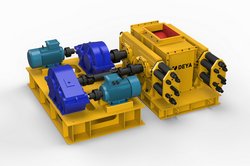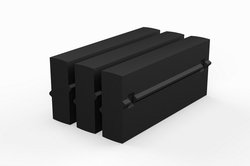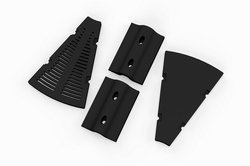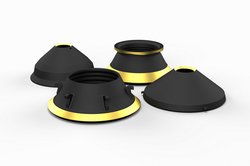Ways to build a high quality stone crusher plant
A stone crusher plant mainly includes crushing equipment, screening equipment, conveying equipment, stocking equipment and electrical control equipment, the following article is for how to build a high quality stone crusher plant, there are some design guidelines and suggestions for equipment purchasing.
1. Design of the stone crusher plant
The design mainly includes three stages: process flow design, plant layout design and equipment selection design.
1.1 Process flow design
When the conditions of feeding and final product size and shape requirements are clear, the process flow to achieve crushing and screening can be multiple programs, the number and selection of equipment selected for different programs are not the same, and therefore the initial investment costs and future operating costs of program implementation will be different, the designer, investor and operator must fully discuss, realistic, weighing the pros and cons to determine the most appropriate process program.
1.2 Plant layout design
According to the main equipment determined by the process flow design, the following aspects should be considered in the plant layout according to the mine site's topography.
1. The distance between raw material in the mine and stone crusher plant feeding hopper, feeding hopper and drop height, equipment layout site, stockpile site and material output mode.
2. Under the smooth material flow conditions, use as few and short as possible belt conveyors.
3. Meet the operation and product delivery of intermediate stockpile yard and finished product yard design, make full use of the site.
4. Mechanical operation and maintenance, convenient operation location and connection of electric control.
5. After the plan layout design is completed, all equipment, including transportation equipment, storage equipment and electrical control, are initially determined.
1.3 Equipment selection design
There are three main types of crushing and screening in a stone crusher plant: stationary, semi-mobile or sled type, and mobile.
The mobile crushing plant is divided into tire type and crawler type (self-propelled) according to the mobile mode.
These three types can be used completely independently or in combination.
For example, the primary crushing unit is mobile, so that multiple sources of stones can be fed and crushed nearby and then transported to a fixed location by belt conveyor, while the secondary and tertiary crushing and screening units are fixed.
The type of stone crusher plant should be determined by the frequency of equipment movement during the operation of the quarry.
Self-propelled equipment is suitable for particularly frequent cases, the most expensive, followed by the tire type, semi-mobile type, the advantage is that these types of equipment installation cycle is short, the amount of civil construction work is small, they can be put into use quickly.
2. Design guidelines and equipment comparison of the stone crusher plant
Various sand and gravel quarries are completely different in terms of the type of rock handled, processing capacity, and requirements of sand and gravel products, so the crushing and screening equipment selected for the design is also different.
2.1 Primary crushing stage
1. Currently, there are three main types of primary stone crushers: jaw crushers, impact crushers and gyratory crushers.
The impact crusher, as a primary crusher, is only suitable for medium to soft rocks, such as limestone, and thus its use is limited.
Large jaw crushers with a maximum feed length of up to 1m, they have become the most used primary crushers. The choice of a jaw crusher depends on two factors: firstly, whether the maximum allowable feed size meets the requirements; secondly, whether the capacity of the discharge opening size meets the system requirements at the determined discharge size.
2. Whether to add vibrating feeder or grizzly screen before the primary crusher depends on the scale of the production line, for the following reasons
①As jaw crushers and other crushers are not allowed to start with a full heavy load cavity, while feeders can start with a load, controlled feeding by the feeder in the previous process, once the abnormal shutdown happens, it can reduce the jaw crushers stock and easy to recover.
②Feeder changes the intermittent feeding of dump trucks and loaders into continuous feeding to the jaw crusher, which reduces the fluctuation of the load of the jaw crusher, and helps to extend the service life of the machine.
③Usually the size of the truck feed is uneven, sometimes big and sometimes small. When there are more large pieces of feed, the jaw crusher loading increases and the crushing speed is slow down, and vice versa.
The vibrating feeder can adjust the feeding speed so that the jaw crusher feeds less when the load is big and more when the crushing speed is fast, which is also conducive to the improvement of the average processing capacity.
3. Feeding equipment generally has four forms available: grizzly sieve feeder, chain plate conveying feeder, motor vibrating feeder and inertia vibrating feeder.
The chain plate conveying feeder or apron feeder is heavy duty and expensive, and the motor vibrating feeder allows a small feed, and both do not have a screening device, so the use of the range is limited.
4. Inertia vibrating feeder is usually installed horizontally, the required drop height is smaller than that of grizzly sieve feeder, so it is suitable for use in the primary crushing unit.
5. Feeding hopper of feeder, not only match with feeder, but also should be determined by the user's feeding method. Self-dumping truck usually adopts end feeding, and loader is side feeding, whose feeding hopper design is different, and the effective volume of feeding hopper should be 1 to 1.5 times larger than the volume of feeding car hopper.
2.2 Secondary Crushing Stage
There are three main types of secondary crushing equipment: fine jaw crusher, cone crusher and impact crusher.
1. Fine jaw crusher was commonly used in small and medium-sized stone crusher plant in the past, but it has been gradually replaced by cone crusher and impact crusher due to its small capacity and too much needle-shaped material in the discharge.
2. Impact crusher is widely used in stone crusher plants in recent years, especially in road quarries, because of its large crushing ratio and less flake particles in the discharge material. The impact crusher has 2 significant weaknesses
First, the installed capacity of the impact crusher will be larger than that of the cone crusher and jaw crusher under the same processing capacity and similar inlet and outlet material grades, because it mainly adopts the impact crushing method, and the blast effect causes greater ineffective energy loss during the high-speed rotation.
The second is that the wear parts are worn out faster, resulting in high operating costs.
How to choose between an impact crusher and a cone crusher
In addition, it has 2 other characteristics
One is more fine particle size in the discharge, which is popular in some use cases such as artificial sand making, while other occasions become disadvantages;.
The second is its selective crushing function, through the drive power, rotor quality and speed, it can control its crushing force, so as to selectively crush softer materials, and almost not crush hard materials, which is convenient for subsequent separation.
3. Cone crusher is a widely used secondary crushing equipment in stone crusher plant at home and abroad.
Its different specifications and different cavity shapes of the same specification can meet the requirements of various processing conditions, which is better suited to the needs of the process, and it runs smoothly and has long service life of wearing parts. It has two kind of weaknesses as well.
First, the operation is relatively complicated, regardless of which cone crushers are selected, it should equipped with hydraulic and lubrication systems to regulate the operating conditions and cool the heat of the bearings.
Secondly, when crushing certain materials (e.g. metamorphic rocks), the rock itself is quite anisotropic, resulting in a high percentage of needle flakes in the discharge material.
2.3 Tertiary crushing stage
The commonly used tertiary crushing equipment are short head cone crusher and vertical shaft impact crusher or VSI sand making machine.
1. When the total crushing of the whole combined crushing and screening plant is relatively large and cannot be achieved by two-stage crushing, three-stage crushing will be designed. For cone crushers, the two crushing stage usually adopts the standard cavity type, while the three crushing stage adopts the short-head cavity type.
2. VSI sand making machine, or Vertical shaft impact crushers are developing rapidly and are commonly used for sand making, shaping and tertiary crushing. By adjusting its rotor structure, rotational speed and motor power, it is possible to control the discharge grade, and its rock flow is particularly smooth and its processing capacity is large.
Vertical shaft impact crusher is not only the best sand making machine, but also has become a development trend to be chosen in tertiary crushing, even secondary crushing.
2.4 Pre-screening & finished product screening stages
On the graded crushing process, the pre-screening unit inserted in the middle of the front and back stage crushing process has two functions.
First, it can reduce the processing capacity of the subsequent crushing process. The pre-screening unit separates the materials that are smaller than the subsequent crushing discharge particle size, thus it reduces the proportion of fine particle size in the subsequent crushing discharge.
Secondly, it can be screened to obtain the required product material without crushing, because the vibrating screen is relatively low price than the crusher, so in the process, "more screening less crushing" is often used in the excellent design of the stone crusher plant.
Pre-screening machine working conditions are characterized by a large feed grade, large throughput, so the screen mesh hole is also large, screening efficiency is not forced to be very high (and not easy to produce blockage), thus, it has different types of pre-screening equipment for option.
Finished sieve for sand and gravel quarry product material screening classification, whether the screen is clean directly affect the quality of sand and gravel quarry products. Usually set the screening efficiency of 90% or more, the screen mesh hole according to the finished material grain level setting, in addition to the use of circular vibrating screen, but also can choose three-axis elliptical screen.
2.5 Sand washing stage
Mechanized sand products must be washed by water, the cleaning of sand and gravel products can remove impurities such as soil mixed with them, and control the content of fine powder, the cleaned sand and gravel as concrete aggregate can improve the quality of concrete and reduce the amount of water. As a result, the use of cleaning units in sand and gravel quarries will become more and more common.
There are two approaches to the cleaning of sand and gravel.
If only want to remove the fine powder in the finished material, it can be cleaned on a vibrating screen. The cleaned water enters the sand and gravel cleaning machine together with the fine granular material smaller than the lower screen, separating the water and fine powder from the sand and gravel to obtain the desired sand and gravel. Water and fines are separated by settling and dewatering and then recovered for recycling.
It can also be cleaned in the sand washer, at this time, according to the amount of fine powder in the finished material, control the speed of the sand and gravel cleaning machine, the overflow of water to control the amount of fine powder washed away and saved.
If the main purpose is to clean the clay stuck on the sand and gravel blocks, the material stone must be scraped off the clay stuck on the stone blocks by using a gravel or rock cleaner before crushing to fine powder, so as to ensure the quality of the sand and gravel after subsequent crushing and screening. This equipment is usually set up before the vibrating screen, which is cleaned first and then screened.
In some sand and gravel quarries, hydraulic classifier is used in the control of sand and gravels to recover fine particles. It is added between the vibrating screen and the sand cleaning machine to adjust the gradation of sand, so that it meets the relevant standards.
2.6 Intermediate silo and finished material stockpile
In order to improve the operation rate of large scale stone crusher plant, intermediate silos are often set up between the initial crushing stage and the secondary crushing stage, which can store a considerable amount of materials and divide the whole system into two sections
Advantages of intermediate silo as follows:
1. When the front section equipment cannot operate normally due to mine reasons, transportation reasons or maintenance equipment, etc., the back section equipment can operate normally for several hours or even days by relying on the stock material in the intermediate silo.
2. It can also be separated from the operating time, usually the initial crushing stage has larger capacity due to the larger feeding size, production time does not have to be too long to meet the daily output, while subsequent equipment does not have to be configured too large, it can increase the daily operation time, so that the existence of the intermediate silo has the potential to make the front and rear section using different operating hours.
Intermediate material stockpile has various structural forms, the common form is to use the surface pile material, excavate the underground channel, and use feeder and belt conveyor to convey the material out from underground. Restricted by terrain, investment, etc., it is generally more appropriate to store 1~2 days of production.
The capacity of the stockpile yard for different specifications of finished products should be proportional to the percentage of that finished product in the total output. The arrangement of the finished product yard depends on the user's finished product output method, for example, loader and dump truck type is different from a total conveying belt sent to the dock for ship loading or railroad for loading, etc.
2.7 Electrical control equipment
The drive of the combined crushing and screening equipment is different due to different types.
Self-propelled crushing plant basically adopts the driving method of diesel engine and hydraulic station, namely, the main engine is directly driven by diesel engine, other equipment such as feeder, vibrating screen, belt conveyor and moving mechanism are driven by hydraulic pressure, equipped with electric control equipment of this driving method.
Tire mobile crushing plant, which may adopt the above-mentioned method, may also adopt diesel generator set power supply method.
Stationary or semi-mobile joint equipment, in addition to the use of diesel generator sets, that is, the use of grid power supply.
The common feature of various crushers is the large static inertia of moving parts, thus their motors have large installed capacity and high starting current. In some countries basically use soft start method to reduce the impact on the electrical net to protect the motor. The whole set of combined equipment includes more than a dozen various motors, voltage and current control of the main motor, and frequency control of the feeder, etc.
From a single machine equipment of the main motor and lubrication and hydraulic equipment in the temperature, pressure and other control of the electrical interlock, to the entire line before and after the control of the equipment switching program, need to be implemented by the electronic control settings.
Any questions welcome to contact us, we will customize the crushing plant for you.





